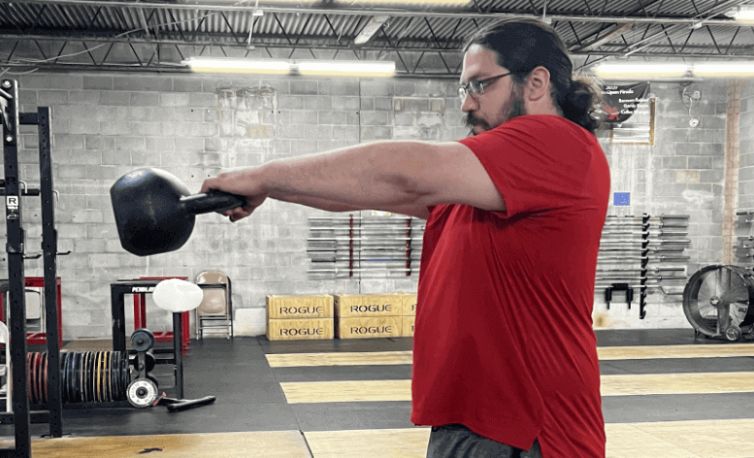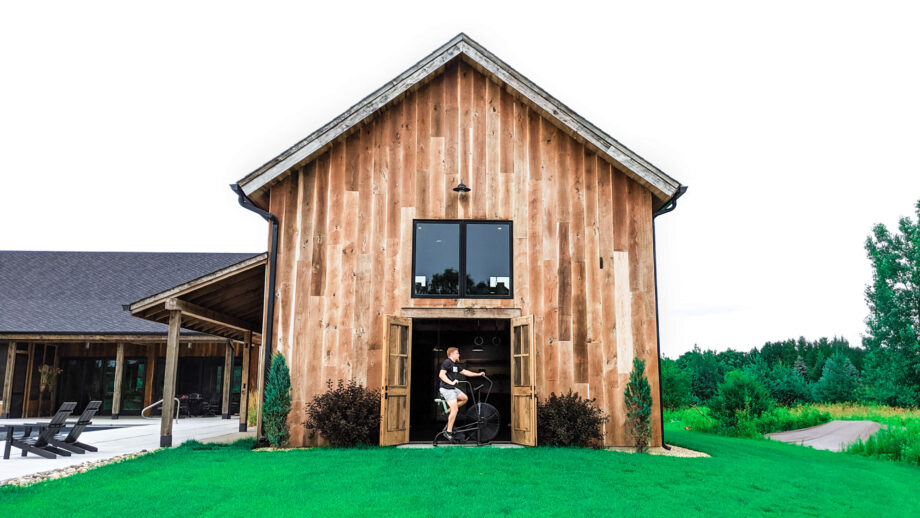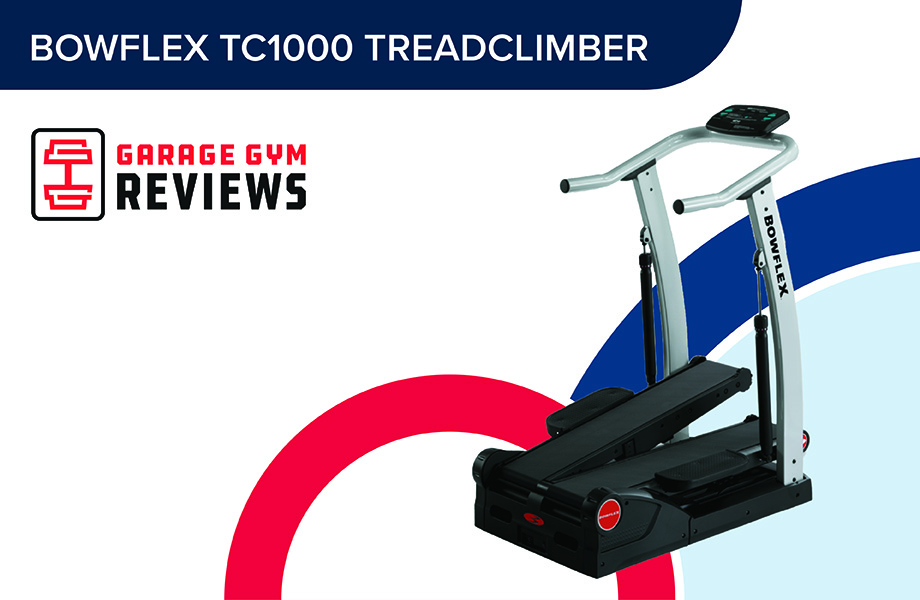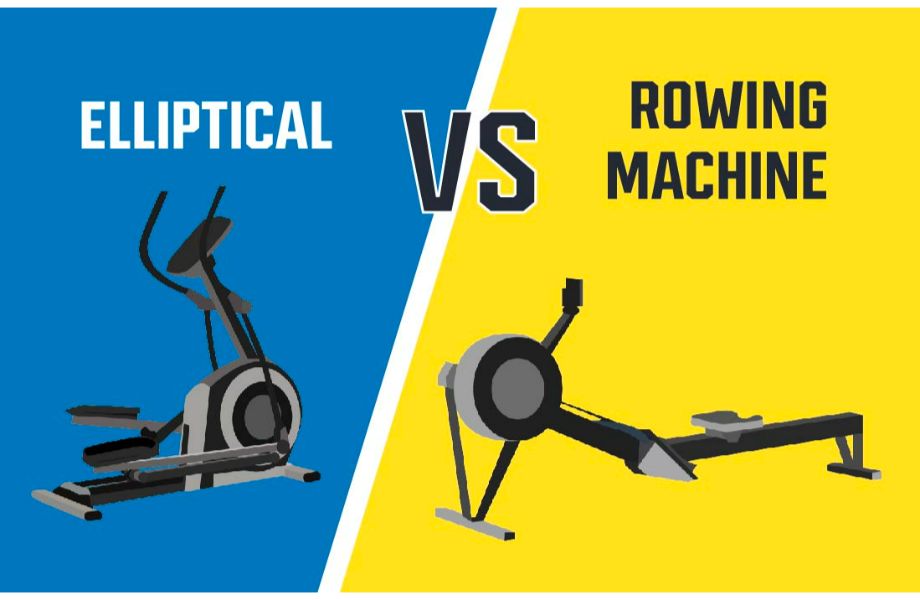We’re super into swinging here at Garage Gym Reviews, and we’re talking about kettlebell swings, of course!
Kettlebells’ popularity goes way back, gaining popularity first in Russia after a 1913 Hercules magazine wrote on the merits of this comprehensive compound exercise. Kettlebell exercises would gain more and more traction in the fitness community as Russia declared it the national sport in 1948.
More recently, the kettlebell has become a staple in CrossFit WODs and functional fitness, exposing a much wider audience to the benefits of kettlebell training.
And what’s not to love about kettlebell swings? This handy dandy exercise targets multiple muscle groups, builds strength, improves cardiovascular endurance, and torches calories all in one fell swoop, no pun intended!
“The kettlebell swing is hands-down one of the most versatile exercises you could be doing in the gym today,” says certified personal trainer and GGR Head of Content Kate Meier.
That’s why we’re breaking down how to do a kettlebell swing, both the Russian and American versions, as well as discussing trainer tips for nailing the form and common mistakes to avoid.
Are you ready to find out what makes the kettlebell swing the king?
How To Do Kettlebell Swings
The setup for both the Russian vs American kettlebell swing is nearly identical, with the primary difference between the two movements being the range of motion, specifically the height at which the upward swing concludes during the concentric phase.
Here are detailed instructions on how to perform these common kettlebell swing variations.
Russian Kettlebell Swings
- Select a kettlebell and hold it with both hands just below your groin using a pronated grip. Your feet should be approximately shoulder-width apart with your back flat, spine neutral, and core held tight.
- Bend your knees slightly, lean forward while maintaining a straight back, then swing the kettlebell upward by thrusting your hips forward.
- Swing the kettlebell to chest height. Try not to scrunch your neck as the kettlebell rises.
- Let the kettlebell swing back to the starting position, hinging again at the hips to accommodate the kettlebell’s momentum.
- The kettlebell will swing between your legs and behind you before slowing down. Once it begins swinging forward, thrust your hips forward once more and cycle into the next rep.
- Repeat as needed.
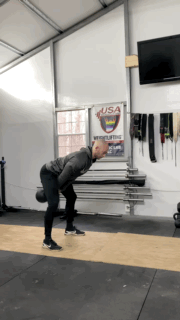
American Kettlebell Swings
- Assume the same starting position as the Russian kettlebell swing. You may want to select a lighter kettlebell since the American version uses an increased range of motion.
- Just as with the Russian version, bend your knees slightly, lean forward, and swing the kettlebell upward using an explosive hip extension movement.
- Swing the kettlebell to the overhead position. Try not to scrunch your neck as the kettlebell reaches its highest point and keep your eyes fixed dead ahead.
- Let the kettlebell swing back to the starting position, hinging again at the hips to accommodate the kettlebell’s momentum. Cycle into the next rep the same way you would for a Russian kettlebell swing.
- Repeat as needed.
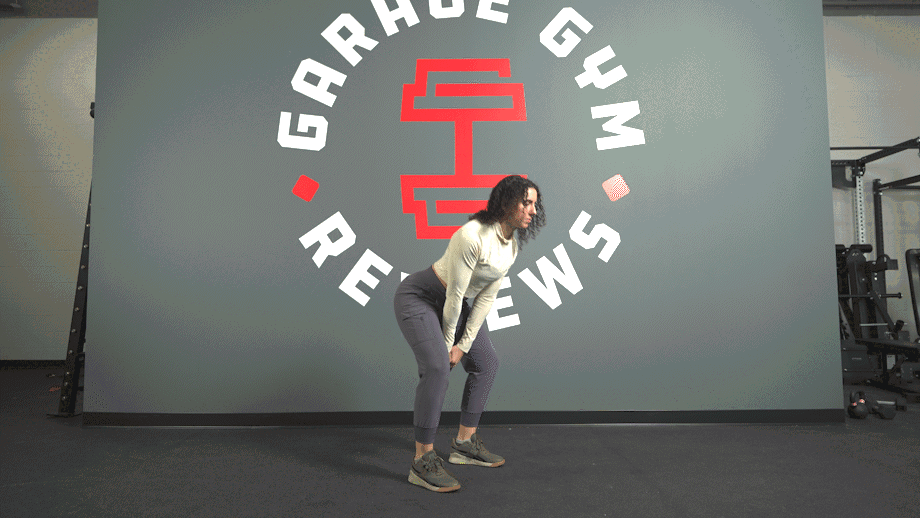
Trainer Tips for Form
Proper form is critical if you’re trying to maximize the effectiveness of your kettlebell workout while simultaneously minimizing the risk of injury.
Keep the following tips, provided by personal trainers on our staff, in mind to make sure you maintain that textbook form whenever you’re performing kettlebell swings.
RELATED: Full-Body Kettlebell Workouts
Keep Your Feet Planted Firmly
Think about where your weight is distributed during the squat or the deadlift; it’s back on the heels. If you wanted to, you should be able to lift up those toes and wiggle them.
It’s the same for the kettlebell swing. You want your feet planted firmly on the ground with the weight back on your heels so you don’t tip forward as the kettlebell swings.
“A strong stance, combined with a great explosion from the hip-hinge movement, is going to provide essentially all of the power needed to get the kettlebell up there in the first place,” Kate says.
If you find the kettlebell is pulling you forward onto your toes and compromising that solid stance, try using a lighter kettlebell. Sure, you want to use momentum during the swing, but you never want to lose your balance mid-movement.
Experiment With Your Stance Width
Notice my use of the word “approximately” on your stance width. The exact width of your stance should fall between hip-width and shoulder-width.
Try experimenting a little to see what feels comfortable. The best stance width will provide you with enough stability to generate power and allow your swing to be fluid and efficient. It should also allow you to perform the movement with no discomfort or pain, other than the soreness from all that muscle activation, of course.
If you’re not quite sure if your stance is up to snuff, consider discussing it with a qualified coach or CPT to make sure it’s effective and safe.
Keep Your Back Straight
Check in with your upper body throughout each portion of the movement. From lifting your kettlebell to hinging forward to lockout, your back must always stay straight. Period.
Not only is this the best way to protect your posterior chain from nasty injuries, it also guarantees you get the most bang for buck during each rep. Pay special attention to this portion of the form when starting out until it is firmly ingrained as muscle memory.
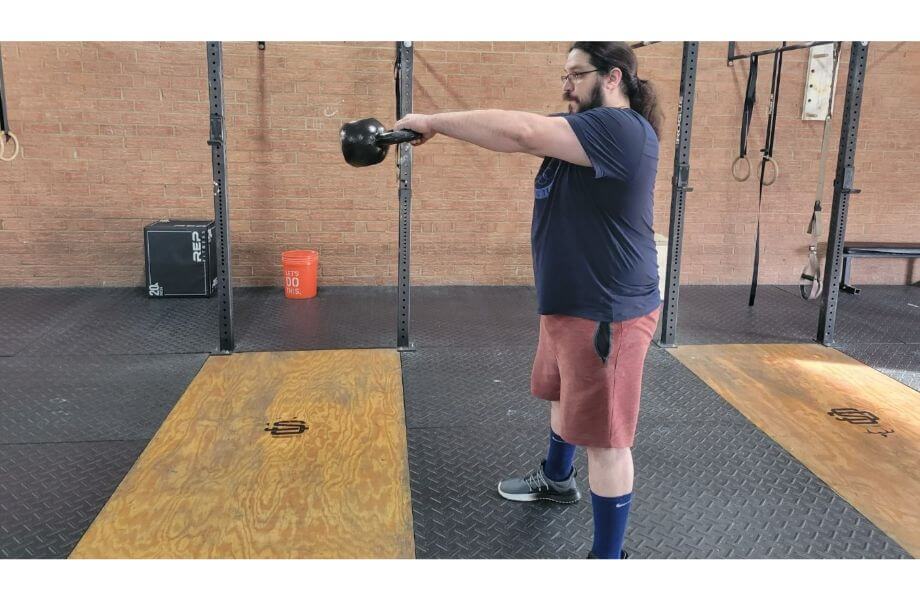
Engage Your Core
Remember why we’re exercising in the first place; to get stronger and improve our health!
Flopping through the movement like a rag doll, therefore, has no place in a strong, well-executed kettlebell swing. To make sure you’re keeping those muscles under tension and maintaining a strong base, engage your abdominal muscles.
“Keeping the core tight both helps you maintain proper form while also protecting your lumbar spine and other muscles along the posterior chain,” Kate says.
Squeeze Your Glutes
The power for your kettlebell swing comes mostly from your hips and glutes. By focusing on driving your hips forward with speed and power and squeezing your glutes, you’re able to effectively propel the kettlebell upward without relying on your arms.
Squeeze those glutes at the top of the movement too to make sure you’re keeping things tight right before the kettlebell swings back down.
RELATED: Kettlebell Workouts For Glutes
Common Kettlebell Swing Mistakes
Even the most seasoned fitness enthusiasts are capable of making mistakes during the kettlebell swing.
Keep an eye out for the following most common mistakes to ensure you’re getting the form right and minimizing your risk of injury.
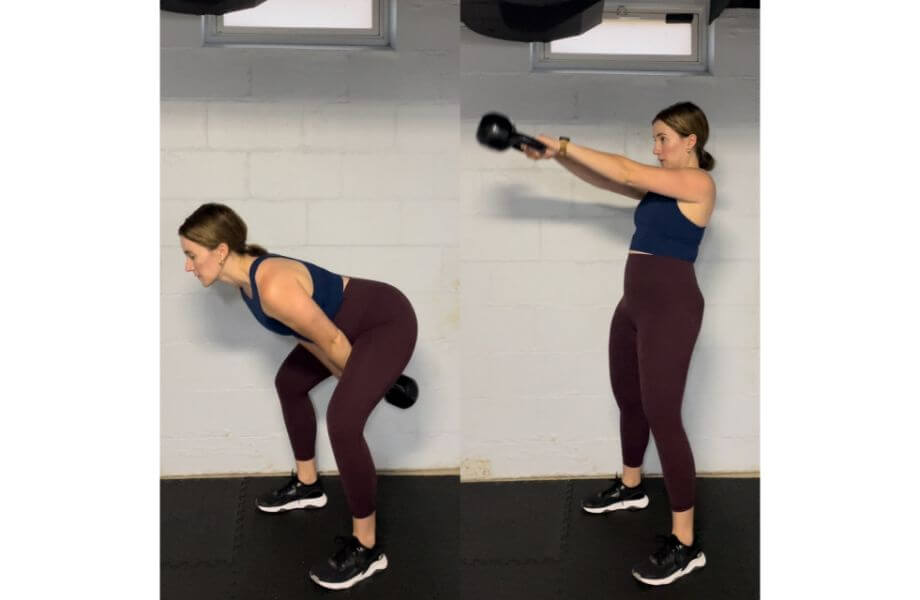
Arching the Back at Lockout
You’re cycling through reps of the American kettlebell swing. You’re in the zone and you feel like an absolute beast. You thrust the kettlebell forward, guiding it along its path, until it reaches that overhead position, and you overextend your back.
Cycling kettlebell swing reps is exciting, and it’s easy to get carried away mid-workout, but it’s important to ensure you don’t arch the back at the lockout position. Doing so places strain on your lower back and could cause injuries like a herniated disc.
Keep your back flat and straight from start to finish, and try not to exaggerate your end position, even if you do feel amazing in the moment. You’ll feel the opposite if you wind up hurting yourself as a result.
Not Keeping a Full Grip on the Handle
It’s easy to put your body on cruise control, especially if you’re in the midst of a long, endurance-type WOD that has you cycling through kettlebell swings for the umpteenth time already.
We know our arms are providing minimal assistance, as the swing gets its power from the hips and glutes, but we very much need to keep our grip at the very least. A loose grip could result in the kettlebell slipping, being dropped, or inadvertently getting launched across the room.
Do not accidentally weaponize the kettlebell. Be sure to keep a full grip on that handle to control the movement throughout the full range of motion.
Allowing the Feet to Rock/Move
We know we have to go heavy to build muscle and inspire hypertrophy, but going too heavy on a kettlebell swing is a surefire way to compromise our good form and hurt the stability of our base. If you find yourself rocking forward with the momentum of the kettlebell and it’s hurting your balance, you should go lighter.
Remember– perfect reps at a lower weight are always better than shaky reps at a higher weight. You’ll work your way up to heavier weight in time. We promise!
Leading With the Arms, Not the Hips
To the untrained eye, it looks like someone doing kettlebell swings is muscling the kettlebell up to shoulder height by pulling it there with their arms. Relying on your arms takes that kettlebell swing, a compound exercise that provides a full-body workout, and turns it into a very inefficient high pull.
The goal is not to pull the kettlebell to its max height with our arms. We want to use a powerful hip thrust and squeeze our abdominals and glutes to provide the power needed for the movement. This is the best way to employ all of the muscles involved.
It’s also much easier to move heavy weights when you’re using your full body instead of just your arms. Don’t believe us? Ask the clean and jerk.
Kettlebell Swing Variations
Of course, the two most popular kettlebell swing variations are the Russian and American kettlebell swings, as outlined above, but how else could we change the movement to fit our fitness goals?
Here are a few more variations to add a little variety to your routine.
Single-Arm Kettlebell Swings
Many popular exercises, from bicep curls to leg extensions, feature a unilateral version. The single-arm kettlebell swing is no exception.
Here’s how to perform a single-arm kettlebell swing with good form:
- Set up as you would for a regular, two-handed kettlebell swing, except grip the kettlebell with only one hand. Keep all other elements of your form the same.
- Bend your knees slightly, lean forward while maintaining a straight back, then swing the kettlebell upward by thrusting your hips forward.
- Swing the kettlebell to your desired height before allowing it to swing back to the starting position. Use the momentum to cycle into your next rep.
- Repeat as needed, then switch sides and repeat the set.
Because you’re now performing the movement with only one hand on the kettlebell, you’ll need to make sure you maintain a strong, steady base and an unbreakable grip on the kettlebell.
You likely will not be able to go as heavy on the single-arm swing compared to the standard two-handed one, so keep this in mind when selecting your kettlebell weight.
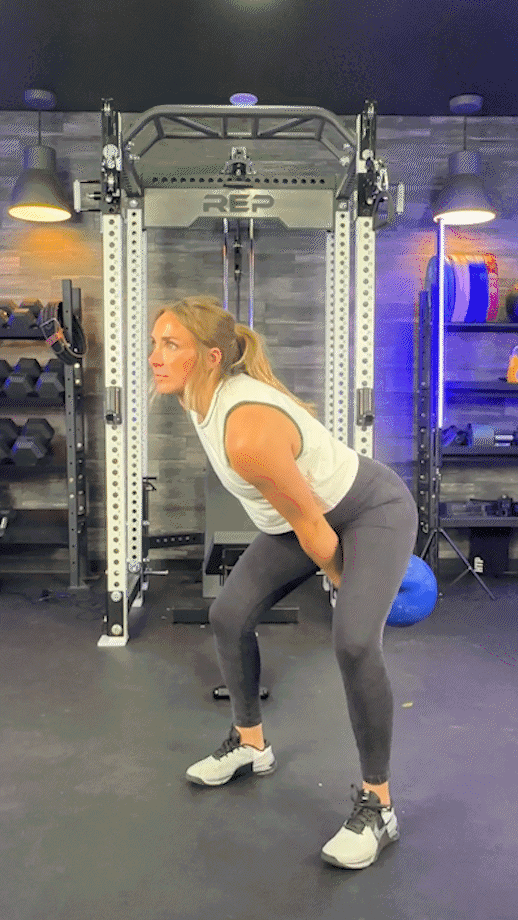
Alternating Kettlebell Swings
Some folks aren’t a fan of single-arm sets, finding it redundant and monotonous to do a whole set for the right side and then do it all over again for the left. Who has the time?
If you want to do a single-arm version without having to put the kettlebell down in between, you might consider alternating kettlebell swings, which are essentially a single-arm kettlebell in which you switch hands at the top of the swing.
Be sure you’re proficient with single-arm kettlebell swings before attempting this movement, and make double, no, triple sure you grab the kettlebell with your other hand before letting go with your first hand.
Remember what we said about weaponizing the kettlebell. We’re performing a ballistic exercise, not launching a ballistic. You have been warned.
Double Kettlebell Swings
As they said in the classic Doublemint gum jingle, “Double your pleasure; double your fun!”
That’s exactly what you’ll get if you double up for a double kettlebell swing, which involves thrusting not one but two kettlebells into the air. Here’s how to perform double kettlebell swings with good form:
- Assume your standard kettlebell swing starting position with your stance wide enough to accommodate two kettlebells instead of one.Hinge forward and pick up the two kettlebells with a neutral grip.
- Guide the kettlebells behind you to essentially prime for your first swing.
- Explosively thrust your hips forward to propel both kettlebells to the desired height before allowing them to swing back to the starting position. We recommend capping the range of motion at chest height, as launching two heavy weights into the overhead position could be problematic if you don’t have 100% control.
- Cycle into the next rep. Repeat as needed.
Performing double kettlebell swings in the gym is a total boss move, but you’ll look foolish, and risk injury, if you’re still sorting out how to do a single kettlebell swing with excellent form.
Make sure to prioritize your regular Russian and American kettlebell swings before graduating to this advanced variant.
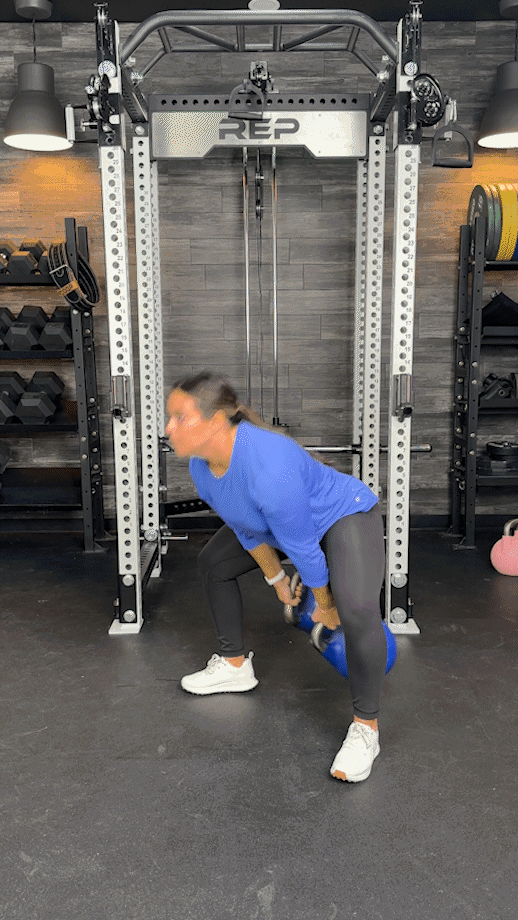
Useful Kettlebell Swing Accessories
At the end of the day, you can knock out a set of kettlebells with just a single kettlebell and your lovely self, but isn’t gearing up part of the fun when it comes to fitness?
Here are a few things that might make that set of kettlebell swings a little easier.
Chalk
What makes kettlebell swings great in the first place is that they provide a true minimalist approach to strength training. One simple free weight unlocks a world of strength gains and cardio benefits.
In the spirit of this minimalist approach, chalk is one of the best kettlebell accessories to enhance your performance. Simple and inexpensive, a coating of chalk before you get into your reps helps you increase friction and maximize your grip strength.
Using chalk helps you lift heavier weights, maintain your hold during high rep schemes, and saves you and others from that scenario we’ve been talking about in which you turn into the Mighty Thor and throw the weight clear across the room.
Don’t risk it. Chalk up!
Flat Shoes
You could feasibly wear your regular gym sneakers or running shoes while doing kettlebell training, but you’ll get better results using flat shoes like deadlift shoes and other weightlifting shoe types.
The reason for this is because the flat sole provides more contact with the ground and, therefore, helps establish a better base. It’s by no means a requisite, but flatter shoes should help provide improvements to your kettlebell swing form.
RELATED: What Shoes Should I Wear For Different Types Of Training?
FAQs: How to Do Kettlebell Swings
Are Russian kettlebell swings better than American?
Russian and American kettlebell swings are both effective tools for general fitness purposes, but does one edge out the other?
Both provide excellent activation to various muscle groups, but the American kettlebell swing may provide superior activation to your upper back and shoulder muscles like the deltoids and rhomboids due to the end position overhead.
On the other hand, Russian kettlebell swing’s reduced range of motion makes it more beginner-friendly and features a lower risk of injury while still boasting a competitive array of benefits.
Because it’s less risky, we give preference to the Russian kettlebell swing, but really there is no right or wrong answer here.
What are the benefits of kettlebell swings?
Kettlebell swings provide a plethora of great benefits.
For starters, kettlebell swings elevate your heart rate, improving cardiovascular fitness similar to running, cycling, and rowing. In fact, a 2014 study published in the International Journal of Exercise Science1 concluded “high-repetition kettlebell swings, regardless of protocol, may elicit a vigorous cardiovascular response,” with greater increases in VO2 max and heart rate observed specifically during Tabata interval training.
Kettlebell swings work many different muscle groups, as well, encouraging improvements in muscle size and strength. A 2012 study published in the Journal of Strength and Conditioning Research2 used electromyography to specifically observe activation in the lats, erector spinae, glutes, quads, and core muscles, most notably the external obliques, illustrating activity from the back muscles all the way down to the lower body.
Strength and power gains made during kettlebell training don’t just end there either. A 2013 study published in the Journal of Strength and Conditioning Research3 observed improvements to the participants’ bench press and clean and jerk following a 10-week kettlebell training class, giving credence to the theory that “kettlebell training can produce a transference of strength and power to weightlifting and powerlifting activities.”
Besides all of these excellent health benefits, kettlebell swings are downright convenient. All you need is a small plot of floor space to set up shop and a single kettlebell, making this equipment and exercise excellent for home gym aficionados and exercise minimalists alike.
What can I do instead of kettlebell swings?
We’ve taken a lot of time today singing the praises of kettlebell swings, but they’re not for everyone. Whether you are medically contraindicated from doing kettlebell swings or just flat out don’t care for them, you’ll want some alternatives to make similar gains.
Here are a few recommendations that target similar muscle groups and provide similar muscle stimulus:
Medicine ball slams
Dumbbell swings
Deadlifts
Squat jumps
Step-ups
Remember to always consult a medical professional prior to beginning any new exercise regimen, whether it includes high-intensity exercises like kettlebell swings or not. It’s always better to play it safe than to wind up sorry!
RELATED: Dumbbells Vs. Kettlebells: The Battle For Free Weight Supremacy
References
1. Fortner HA, Salgado JM, Holmstrup AM, Holmstrup ME. Cardiovascular and Metabolic Demands of the Kettlebell Swing using Tabata Interval versus a Traditional Resistance Protocol. Int J Exerc Sci. 2014;7(3):179-185. Published 2014 Jul 1.
2. McGill SM, Marshall LW. Kettlebell swing, snatch, and bottoms-up carry: back and hip muscle activation, motion, and low back loads. J Strength Cond Res. 2012;26(1):16-27. doi:10.1519/JSC.0b013e31823a4063
3. Manocchia P, Spierer DK, Lufkin AK, Minichiello J, Castro J. Transference of kettlebell training to strength, power, and endurance. J Strength Cond Res. 2013;27(2):477-484. doi:10.1519/JSC.0b013e31825770fe


